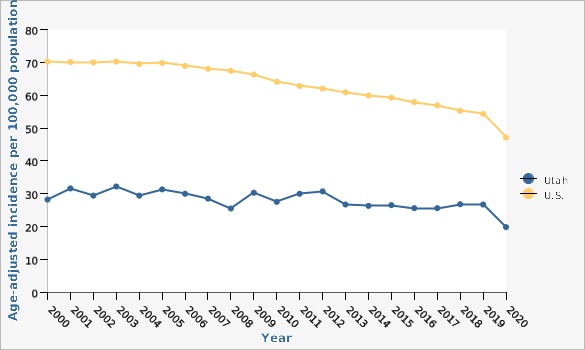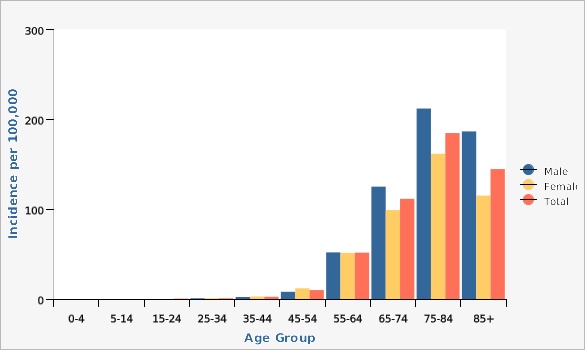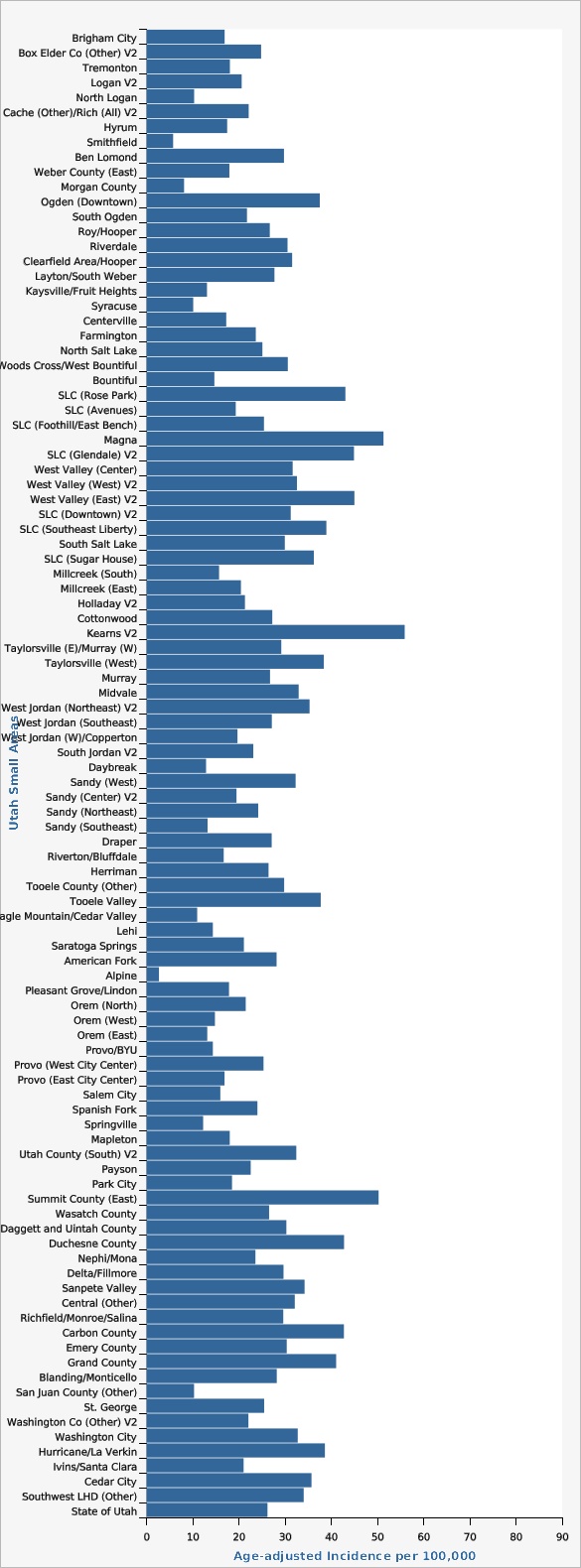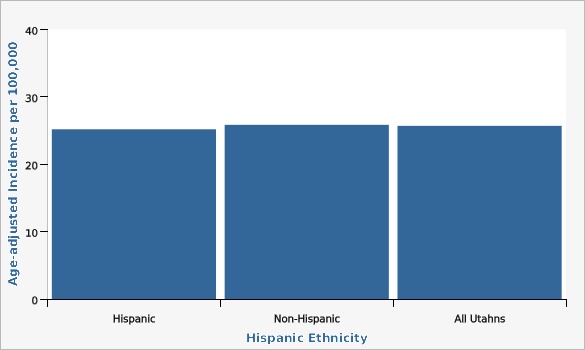Complete Health Indicator Report of Lung Cancer Incidence
Definition
The rate of lung cancer incidence in Utah per 100,000 population.Numerator
The number of incidents of lung cancer among Utah residents for a given time period (ICD-10: C33-C34).Denominator
The population of Utah or U.S. for a specific time period.Why Is This Important?
Lung cancer is the leading cause of cancer-related death in Utah and the U.S. Because symptoms often do not appear until the disease is advanced, early detection of this cancer is difficult. Cigarette smoking is the single most important risk factor for lung cancer. There are more than 80 carcinogens in cigarette smoke. Other risk factors include occupational or environmental exposure to secondhand smoke, radon, asbestos (particularly among smokers), certain metals (chromium, cadmium, arsenic), some organic chemicals, radiation, air pollution, and a medical history of tuberculosis. Genetic susceptibility plays a contributing role in the development of lung cancer, especially in those who develop the disease at a younger age.How Are We Doing?
In 2017, the Utah lung cancer incidence rate was 24.98 cases per 100,000 people. This rate has not changed much since 2000. Lung cancer incidence increases with age, especially over the age of 65. Men over the age of 65 are diagnosed with lung cancer at significantly higher rates (174.1 cases per 100,000 men) than women of the same age group (119.6 cases per 100,000 women). Geographically, lung cancer incidence rates range from a low of 16.1 cases per 100,000 people in Utah County LHD to a high of 38.4 cases per 100,000 people in TriCounty LHD (see County and Small Area views for additional information on lung cancer incidence by geography). For combined data years 2014-2016, there was no significant difference in lung cancer incidence rates between Hispanic and Non-Hispanic Utahns. However, those who racially identify as Black or African American had significantly higher lung cancer incidence rates (58.5 cases per 100,000 persons) compared to the overall state rate (25.7 cases per 100,000 persons) for the same time period.How Do We Compare With the U.S.?
The lung cancer incidence rate in Utah is approximately half the U.S. rate. In 2016 (the most recent national data available), the U.S. lung cancer incidence rate was 56 lung cancer cases per 100,000 people compared to the Utah rate of 25.6 cases per 100,000 people.What Is Being Done?
Since nearly 90% of lung cancer deaths can be attributed to smoking, public health programs to reduce lung cancer focus on tobacco prevention and control. Utah's statewide Tobacco Prevention and Control Program coordinates efforts to accomplish the following four goals: to prevent youth from starting to use tobacco, to help tobacco users quit, to eliminate exposure to secondhand smoke, and to reduce tobacco-related disparities. In addition, the Utah Department of Health initiated the Utah Cancer Action Network (UCAN), a statewide partnership whose goal is to reduce the burden of cancer. The mission of the UCAN is to lower cancer incidence and mortality in Utah through collaborative efforts directed toward cancer prevention and control. As a result of this planning process, objectives and strategies have been developed by community partners regarding the early detection of cervical, breast, and colorectal cancers as well as the promotion of physical activity, healthy eating habits, melanoma cancer prevention and cancer survivorship advocacy.Available Services
The Tobacco Prevention and Control Program (TPCP) provides technical expertise and coordination at state and community levels to prevent and reduce tobacco use in Utah. TPCP programs include statewide and community based services to help smokers quit, The TRUTH anti-tobacco marketing campaign, and youth tobacco prevention partnerships with local health departments, schools, and community agencies. Free services that assist smokers with quitting include the Utah Tobacco Quit Line (1-888-567-TRUTH), a web-based cessation service ([http://www.utahquitnet.com www.utahquitnet.com]), and school- and community-based quit programs for teens, adults, and pregnant women. Further efforts to reduce the negative health effects of tobacco use focus on strengthening tobacco-free policies and reducing youth access to tobacco products. The Tobacco Prevention and Control Program monitors smoking prevalence among adult Utahns through the statewide Behavioral Risk Factor Surveillance System and among students through the Youth Risk Behavior Survey.Health Program Information
Free services that assist smokers with quitting include the Utah Tobacco Quit Line (1-888-567-TRUTH), a web-based cessation service ([http://www.utahquitnet.com www.utahquitnet.com]), and school- and community-based quit programs for teens, adults, and pregnant women.Related Indicators
Relevant Population Characteristics
The risk of developing lung cancer increases with age.Related Relevant Population Characteristics Indicators:
Risk Factors
Cigarette smoking is the most important risk factor for lung cancer. Other risk factors include occupational exposures such as radon and asbestos and indoor and outdoor pollution, including environmental tobacco smoke.Related Risk Factors Indicators:
Health Status Outcomes
In addition to causing lung cancer, smoking also causes heart disease, damages lung function, and raises blood pressure.Related Health Status Outcomes Indicators:
Graphical Data Views
| Utah vs. U.S. | Year | Age-adjusted Incidence per 100,000 Population | Lower Limit | Upper Limit | ||
|---|---|---|---|---|---|---|
Record Count: 36 | ||||||
| Utah | 2000 | 28.2 | 25.6 | 31.0 | ||
| Utah | 2001 | 31.6 | 28.9 | 34.5 | ||
| Utah | 2002 | 29.4 | 26.8 | 32.1 | ||
| Utah | 2003 | 32.1 | 29.4 | 34.9 | ||
| Utah | 2004 | 29.4 | 26.9 | 32.1 | ||
| Utah | 2005 | 31.2 | 28.6 | 33.9 | ||
| Utah | 2006 | 29.9 | 27.5 | 32.5 | ||
| Utah | 2007 | 28.4 | 26.1 | 31.0 | ||
| Utah | 2008 | 25.5 | 23.3 | 27.8 | ||
| Utah | 2009 | 30.3 | 28.0 | 32.8 | ||
| Utah | 2010 | 27.5 | 25.3 | 29.8 | ||
| Utah | 2011 | 29.8 | 27.6 | 32.2 | ||
| Utah | 2012 | 30.7 | 28.4 | 33.1 | ||
| Utah | 2013 | 26.7 | 24.6 | 28.9 | ||
| Utah | 2014 | 26.1 | 24.1 | 28.3 | ||
| Utah | 2015 | 26.3 | 24.3 | 28.5 | ||
| Utah | 2016 | 25.6 | 23.6 | 27.6 | ||
| Utah | 2017 | 25.0 | 23.1 | 27.0 | ||
| U.S. | 1999 | 70.6 | 70.3 | 71.0 | ||
| U.S. | 2000 | 70.1 | 69.8 | 70.4 | ||
| U.S. | 2001 | 70.1 | 69.8 | 70.4 | ||
| U.S. | 2002 | 70.0 | 69.7 | 70.3 | ||
| U.S. | 2003 | 70.2 | 70.0 | 70.6 | ||
| U.S. | 2004 | 69.5 | 69.2 | 69.8 | ||
| U.S. | 2005 | 69.8 | 69.5 | 70.1 | ||
| U.S. | 2006 | 68.9 | 68.6 | 69.2 | ||
| U.S. | 2007 | 68.0 | 67.7 | 68.3 | ||
| U.S. | 2008 | 67.4 | 67.1 | 67.7 | ||
| U.S. | 2009 | 66.3 | 66.0 | 66.5 | ||
| U.S. | 2010 | 64.0 | 63.7 | 64.3 | ||
| U.S. | 2011 | 62.7 | 62.4 | 63.0 | ||
| U.S. | 2012 | 61.8 | 61.5 | 62.1 | ||
| U.S. | 2013 | 60.7 | 60.4 | 61.0 | ||
| U.S. | 2014 | 59.5 | 59.3 | 59.8 | ||
| U.S. | 2015 | 58.7 | 58.2 | 58.7 | ||
| U.S. | 2016 | 56.0 | 55.8 | 56.2 | ||
Data Notes
Age-adjusted to U.S. 2000 population. [[br]] ^ ^*U.S. data available through 2016.Data Sources
- Cancer data provided by the Utah Cancer Registry, supported by the National Cancer Institute (HHSN261201800016I), the U.S. Center for Disease Control and Prevention (NU58DP0063200), the University of Utah, and Huntsman Cancer Foundation
- Population Estimates: National Center for Health Statistics (NCHS) through a collaborative agreement with the U.S. Census Bureau, IBIS Version 2016
- U.S. Cancer Statistics: WONDER Online Database. United States Department of Health and Human Services, Centers for Disease Control and Prevention and National Cancer Institute. Accessed at [http://wonder.cdc.gov/cancer.html]
| Males vs. Females | Age Group | Incidence per 100,000 | Lower Limit | Upper Limit | ||
|---|---|---|---|---|---|---|
Record Count: 6 | ||||||
| Male | <45 | 0.9 | 0.5 | 1.4 | ||
| Male | 45-64 | 31.6 | 28.0 | 35.5 | ||
| Male | 65+ | 174.0 | 162.0 | 186.8 | ||
| Female | <45 | 1.3 | 0.8 | 1.9 | ||
| Female | 45-64 | 30.0 | 26.5 | 33.8 | ||
| Female | 65+ | 119.6 | 110.3 | 129.4 | ||
Data Sources
- Cancer data provided by the Utah Cancer Registry, supported by the National Cancer Institute (HHSN261201800016I), the U.S. Center for Disease Control and Prevention (NU58DP0063200), the University of Utah, and Huntsman Cancer Foundation
- Population Estimates: National Center for Health Statistics (NCHS) through a collaborative agreement with the U.S. Census Bureau, IBIS Version 2017
| Local Health District | Age-adjusted Rate per 100,000 Population | Lower Limit | Upper Limit | Note | ||
|---|---|---|---|---|---|---|
Record Count: 14 | ||||||
| Bear River | 17.1 | 12.7 | 22.5 | |||
| Central | 31.8 | 24.1 | 41.2 | |||
| Davis County | 20.4 | 16.7 | 24.6 | |||
| Salt Lake County | 27.8 | 25.5 | 30.3 | |||
| San Juan | 16.6 | 5.3 | 39.3 | ^ | ||
| Southeast | 36.3 | 25.3 | 50.4 | ^ | ||
| Southwest | 26.9 | 22.9 | 31.4 | |||
| Summit | 38.1 | 23.5 | 58.3 | |||
| Tooele | 36.6 | 25.4 | 50.9 | |||
| TriCounty | 38.4 | 27.0 | 52.9 | |||
| Utah County | 16.1 | 13.3 | 19.4 | |||
| Wasatch | 19.4 | 8.9 | 36.7 | |||
| Weber-Morgan | 27.3 | 22.8 | 32.5 | |||
| State of Utah | 25.3 | 23.9 | 26.7 | |||
Data Notes
Age-adjusted to U.S. 2000 standard population. ^ ^^Prior to 2015 San Juan County was part of the Southeast Local Health District. In 2015 the San Juan County Local Health District was formed. Data reported are for all years using the current boundaries.Data Sources
- Cancer data provided by the Utah Cancer Registry, supported by the National Cancer Institute (HHSN261201800016I), the U.S. Center for Disease Control and Prevention (NU58DP0063200), the University of Utah, and Huntsman Cancer Foundation
- Population Estimates: National Center for Health Statistics (NCHS) through a collaborative agreement with the U.S. Census Bureau, IBIS Version 2017
| Utah Small Areas | Age-adjusted Incidence per 100,000 | Lower Limit | Upper Limit | |||
|---|---|---|---|---|---|---|
Record Count: 100 | ||||||
| Brigham City | 16.9 | 9.0 | 29.0 | |||
| Box Elder Co (Other) V2 | 24.8 | 11.1 | 47.8 | |||
| Tremonton | 18.1 | 7.7 | 35.8 | |||
| Logan V2 | 20.6 | 12.9 | 31.2 | |||
| North Logan | 10.3 | 3.3 | 24.3 | |||
| Cache (Other)/Rich (All) V2 | 22.1 | 12.2 | 37.0 | |||
| Hyrum | 17.5 | 3.2 | 53.6 | |||
| Smithfield | 5.8 | 0.7 | 21.1 | |||
| Ben Lomond | 29.8 | 21.6 | 40.1 | |||
| Weber County (East) | 18.0 | 10.8 | 28.0 | |||
| Morgan County | 8.1 | 1.7 | 23.8 | |||
| Ogden (Downtown) | 37.5 | 25.3 | 53.6 | |||
| South Ogden | 21.8 | 14.1 | 32.0 | |||
| Roy/Hooper | 26.7 | 17.8 | 38.4 | |||
| Riverdale | 30.5 | 19.5 | 45.6 | |||
| Clearfield Area/Hooper | 31.5 | 22.4 | 43.2 | |||
| Layton/South Weber | 27.7 | 20.3 | 37.0 | |||
| Kaysville/Fruit Heights | 13.1 | 6.4 | 23.6 | |||
| Syracuse | 10.1 | 3.7 | 22.2 | |||
| Centerville | 17.3 | 7.3 | 34.4 | |||
| Farmington | 23.7 | 11.4 | 43.4 | |||
| North Salt Lake | 25.1 | 11.0 | 49.1 | |||
| Woods Cross/West Bountiful | 30.6 | 12.2 | 63.5 | |||
| Bountiful | 14.7 | 9.6 | 21.5 | |||
| SLC (Rose Park) | 43.1 | 29.1 | 61.4 | |||
| SLC (Avenues) | 19.3 | 10.9 | 31.7 | |||
| SLC (Foothill/East Bench) | 25.4 | 15.3 | 39.8 | |||
| Magna | 51.3 | 32.0 | 78.0 | |||
| SLC (Glendale) V2 | 44.9 | 26.6 | 71.1 | |||
| West Valley (Center) | 31.6 | 22.1 | 44.0 | |||
| West Valley (West) V2 | 32.6 | 18.8 | 52.4 | |||
| West Valley (East) V2 | 45.0 | 33.5 | 59.2 | |||
| SLC (Downtown) V2 | 31.2 | 21.0 | 44.7 | |||
| SLC (Southeast Liberty) | 39.0 | 23.3 | 61.0 | |||
| South Salt Lake | 30.0 | 18.2 | 46.5 | |||
| SLC (Sugar House) | 36.2 | 25.3 | 50.3 | |||
| Millcreek (South) | 15.7 | 8.5 | 26.6 | |||
| Millcreek (East) | 20.4 | 12.2 | 32.1 | |||
| Holladay V2 | 21.3 | 13.4 | 32.3 | |||
| Cottonwood | 27.2 | 19.8 | 36.5 | |||
| Kearns V2 | 55.9 | 38.9 | 77.9 | |||
| Taylorsville (E)/Murray (W) | 29.2 | 19.6 | 41.9 | |||
| Taylorsville (West) | 38.4 | 26.7 | 53.5 | |||
| Murray | 26.8 | 18.0 | 38.3 | |||
| Midvale | 33.0 | 21.6 | 48.1 | |||
| West Jordan (Northeast) V2 | 35.3 | 22.3 | 53.2 | |||
| West Jordan (Southeast) | 27.1 | 16.0 | 43.1 | |||
| West Jordan (W)/Copperton | 19.7 | 7.5 | 42.0 | |||
| South Jordan V2 | 23.1 | 15.1 | 33.8 | |||
| Daybreak | 12.9 | 0.8 | 57.0 | |||
| Sandy (West) | 32.3 | 20.8 | 47.9 | |||
| Sandy (Center) V2 | 19.5 | 10.7 | 32.6 | |||
| Sandy (Northeast) | 24.2 | 14.7 | 37.5 | |||
| Sandy (Southeast) | 13.2 | 6.6 | 23.6 | |||
| Draper | 27.1 | 16.1 | 42.8 | |||
| Riverton/Bluffdale | 16.7 | 8.6 | 29.3 | |||
| Herriman | 26.4 | 11.3 | 52.4 | |||
| Tooele County (Other) | 29.8 | 14.1 | 55.3 | |||
| Tooele Valley | 37.7 | 26.8 | 51.7 | |||
| Eagle Mountain/Cedar Valley | 11.0 | 3.0 | 28.3 | |||
| Lehi | 14.4 | 7.4 | 25.2 | |||
| Saratoga Springs | 21.1 | 6.0 | 52.9 | |||
| American Fork | 28.2 | 18.4 | 41.3 | |||
| Alpine | 2.7 | 0.1 | 15.1 | |||
| Pleasant Grove/Lindon | 17.9 | 10.6 | 28.1 | |||
| Orem (North) | 21.5 | 12.2 | 35.2 | |||
| Orem (West) | 14.8 | 7.0 | 27.4 | |||
| Orem (East) | 13.2 | 6.0 | 25.1 | |||
| Provo/BYU | 14.4 | 7.5 | 25.0 | |||
| Provo (West City Center) | 25.3 | 13.2 | 44.0 | |||
| Provo (East City Center) | 16.9 | 4.5 | 43.8 | |||
| Salem City | 16.0 | 3.3 | 46.8 | |||
| Spanish Fork | 24.0 | 13.5 | 39.5 | |||
| Springville | 12.3 | 5.2 | 24.4 | |||
| Mapleton | 18.0 | 4.8 | 46.8 | |||
| Utah County (South) V2 | 32.4 | 13.0 | 66.8 | |||
| Payson | 22.6 | 11.7 | 39.4 | |||
| Park City | 18.5 | 7.4 | 38.3 | |||
| Summit County (East) | 50.3 | 28.0 | 83.2 | |||
| Wasatch County | 26.6 | 15.8 | 41.9 | |||
| Daggett and Uintah County | 30.3 | 20.0 | 44.1 | |||
| Duchesne County | 42.8 | 27.0 | 64.4 | |||
| Nephi/Mona | 23.6 | 8.6 | 51.7 | |||
| Delta/Fillmore | 29.7 | 14.7 | 53.4 | |||
| Sanpete Valley | 34.2 | 21.0 | 52.8 | |||
| Central (Other) | 32.1 | 20.8 | 47.4 | |||
| Richfield/Monroe/Salina | 29.6 | 16.4 | 49.2 | |||
| Carbon County | 42.8 | 28.5 | 61.6 | |||
| Emery County | 30.4 | 14.2 | 56.8 | |||
| Grand County | 41.1 | 22.6 | 68.6 | |||
| Blanding/Monticello | 28.2 | 10.1 | 62.4 | |||
| San Juan County (Other) | 10.3 | 1.1 | 38.8 | |||
| St. George | 25.5 | 20.4 | 31.4 | |||
| Washington Co (Other) V2 | 22.1 | 9.7 | 42.9 | |||
| Washington City | 32.8 | 21.5 | 47.8 | |||
| Hurricane/La Verkin | 38.6 | 26.7 | 54.0 | |||
| Ivins/Santa Clara | 21.0 | 10.7 | 37.2 | |||
| Cedar City | 35.7 | 25.1 | 49.4 | |||
| Southwest LHD (Other) | 34.0 | 23.3 | 48.0 | |||
| State of Utah | 26.2 | 25.0 | 27.4 | |||
Data Notes
Age adjusted to the U.S. 2000 standard population.[[br]] ^ ^*Use caution in interpreting, the estimate has a relative standard error greater than 30% and does not meet UDOH standards for reliability. For more information, please go to [http://ibis.health.utah.gov/pdf/resource/DataSuppression.pdf].Data Sources
- Cancer data provided by the Utah Cancer Registry, supported by the National Cancer Institute (HHSN261201800016I), the U.S. Center for Disease Control and Prevention (NU58DP0063200), the University of Utah, and Huntsman Cancer Foundation
- Population estimates produced by the UDOH Center for Health Data and Informatics. Linear interpolation of U.S. Census Bureau and ESRI ZIP Code data provided annual population estimates for ZIP Code areas by sex and age groups, IBIS Version 2017
| Race | Age-adjusted Incidence per 100,000 | Lower Limit | Upper Limit | |||
|---|---|---|---|---|---|---|
Record Count: 6 | ||||||
| American Indian/Native Alaskan | 11.5 | 3.9 | 26.4 | |||
| Asian | 26.4 | 18.4 | 36.9 | |||
| Black | 58.5 | 35.6 | 90.7 | |||
| Pacific Islander | 21.4 | 10.5 | 38.5 | |||
| White | 25.8 | 24.6 | 27.0 | |||
| All Races | 25.7 | 24.5 | 26.9 | |||
Data Notes
Age-adjusted to U.S. 2000 population.Data Sources
- Cancer data provided by the Utah Cancer Registry, supported by the National Cancer Institute (HHSN261201800016I), the U.S. Center for Disease Control and Prevention (NU58DP0063200), the University of Utah, and Huntsman Cancer Foundation
- Population Estimates by Age, Sex, Race, and Hispanic Origin for Counties in Utah, U.S. Bureau of the Census, IBIS Version 2016
| Hispanic Ethnicity | Age-adjusted Incidence per 100,000 | Lower Limit | Upper Limit | |||
|---|---|---|---|---|---|---|
Record Count: 3 | ||||||
| Hispanic | 25.2 | 20.4 | 30.8 | |||
| Non-Hispanic | 25.8 | 24.7 | 27.1 | |||
| All Utahns | 25.7 | 24.5 | 26.9 | |||
Data Notes
Age-adjusted to U.S. 2000 population.Data Sources
- Cancer data provided by the Utah Cancer Registry, supported by the National Cancer Institute (HHSN261201800016I), the U.S. Center for Disease Control and Prevention (NU58DP0063200), the University of Utah, and Huntsman Cancer Foundation
- Population Estimates by Age, Sex, Race, and Hispanic Origin for Counties in Utah, U.S. Bureau of the Census, IBIS Version 2016
Lung Cancer Number of Cases by Year, Utah, 2000-2017
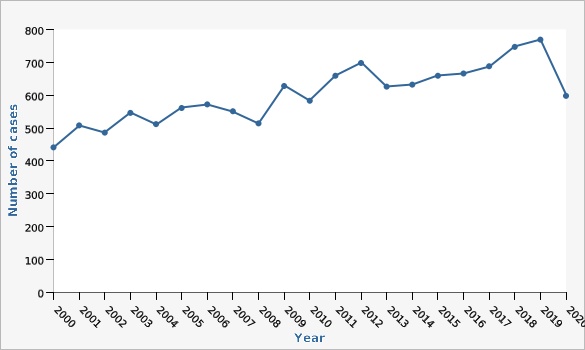
| Year | Number of Cases | |||||
|---|---|---|---|---|---|---|
Record Count: 18 | ||||||
| 2000 | 441 | |||||
| 2001 | 508 | |||||
| 2002 | 485 | |||||
| 2003 | 545 | |||||
| 2004 | 512 | |||||
| 2005 | 560 | |||||
| 2006 | 570 | |||||
| 2007 | 551 | |||||
| 2008 | 514 | |||||
| 2009 | 628 | |||||
| 2010 | 582 | |||||
| 2011 | 657 | |||||
| 2012 | 698 | |||||
| 2013 | 626 | |||||
| 2014 | 628 | |||||
| 2015 | 656 | |||||
| 2016 | 664 | |||||
| 2017 | 673 | |||||
Data Source
Cancer data provided by the Utah Cancer Registry, supported by the National Cancer Institute (HHSN261201800016I), the U.S. Center for Disease Control and Prevention (NU58DP0063200), the University of Utah, and Huntsman Cancer FoundationReferences and Community Resources
Tobacco Prevention and Control Program, Utah Department of Health: [http://www.tobaccofreeutah.org][[br]] Utah Tobacco Quit Line: 1-888-567-TRUTH][[br]] Utah Cessation Services: [http://www.utah.quitnet.com][[br]] American Cancer Society: [http://www.cancer.org][[br]] National Cancer Institute: [http://www.cancer.gov][[br]] Huntsman Cancer Institute: [http://www.huntsmancancer.org][[br]] American Lung Association: [http://www.lungusa.org][[br]] Utah Cancer Control Progam: [http://www.cancerutah.org][[br]] Utah Cancer Action Network: [http://www.ucan.cc]More Resources and Links
Evidence-based community health improvement ideas and interventions may be found at the following sites:- Centers for Disease Control and Prevention (CDC) WONDER Database, a system for disseminating public health data and information.
- United States Census Bureau data dashboard.
- Utah healthy Places Index, evidence-based and peer-reviewed tool, supports efforts to prioritize equitable community investments, develop critical programs and policies across the state, and much more.
- County Health Rankings
- Kaiser Family Foundation's StateHealthFacts.org
- Medical literature can be queried at PubMed library.
Page Content Updated On 02/21/2020,
Published on 03/12/2021

